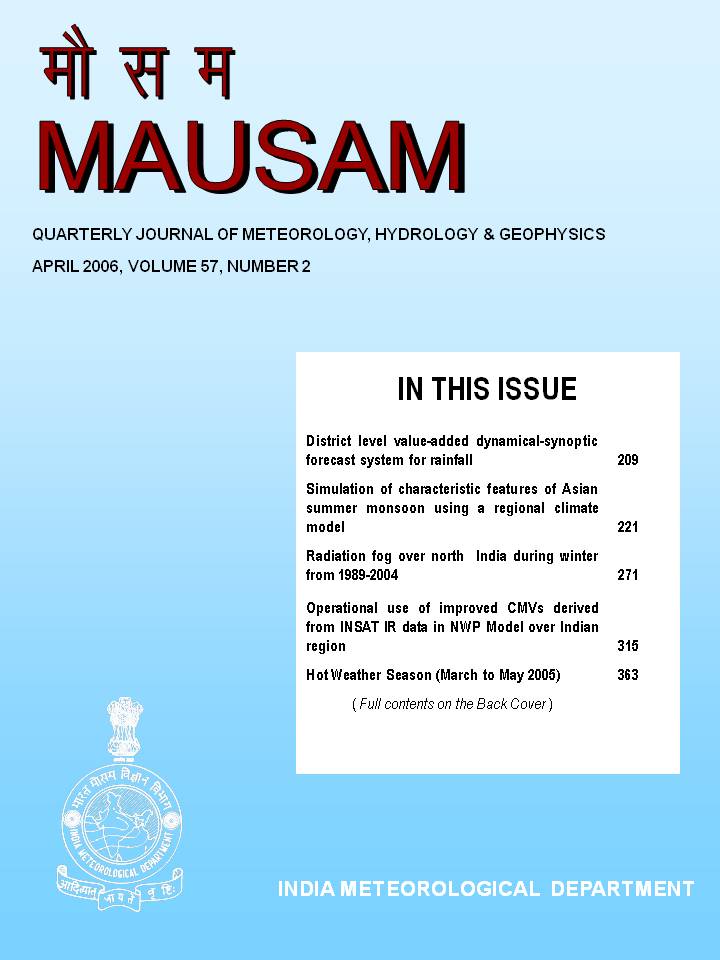Radiation fog over north India during winter from 1989-2004
DOI:
https://doi.org/10.54302/mausam.v57i2.474Abstract
Lkkj & bl 'kks/k-i= esa rsjg gokbZ vM~Mksa ds orZeku ekSle laca/kh vk¡dMksa dk mi;ksx djrs gq, mÙkjh Hkkjr esa fofdj.k ;qDr dksgjs dk v/;;u fd;k x;k gSA gky gh ds o"kksZa esa Hkkjr ds mÙkjh Hkkxksa esa dksgjs dh mRifÙk esa cgqr vf/kd o`f) ik;h xbZ gSA pw¡fd bafnjk xk¡/kh vUrjjk"Vªh; ¼vkbZ- th- vkbZ-½ gokbZ vM~Ms dh o"kZ 1997&1998] 1998&1999] 1999&2000] 2000&2001] 2001&2002] 2002&2003 vkSj 2003&2004 ds nkSjku dqy 900 mM+kuksa ds ekxZ cnys x,A blfy, bl gokbZ vM~Ms ds oSekfudh izpkyuksa ij iM+s dksgjs ds izfrdwy izHkko dk v/;;u fd;k x;k gSA bafnjk xk¡/kh gokbZ vM~Ms ij dSV&I, dSV&II vkSj dSV&III izpkyuksa ds fy, foekuksa dks mrkjus esa lgk;d vR;f/kd l{ke midj.k iz.kkyh vkbZ- ,y- ,l- miyC/k djkbZ xbZ gSA bl 'kks/k&i= esa xr iUnzg o"kksZa ds LdksiksxzkQksa ifjdfyr de n`’;rk okys izpkyuksa ds fy, vko’;d juos dh n`’; jsatksa vkj- oh- vkj- dh mi;ksfxrk ij fopkj&foe’kZ fd;k x;k gSA mixzg }kjk dksgjs ij fd, x, izs{k.kksa dk /kjkryh; izs{k.kksa ds lkFk lgh rkyesy ik;k x;k gSA mixzg ls izkIr gq, fp= bl ckr dk izek.k gSa fd o"kZ 1998&1999 ds nkSjku mŸkjh Hkkjr esa vR;f/kd l?ku dksgjk vjc lkxj esa cus izpaM pØokr ls vR;f/kd ek=k esa vknzZrk ds izokg ds dkj.k cuk FkkA bl 'kks/k-i= esa bafnjk xk¡/kh gokbZ vM~Mk] y[kuÅ gokbZ vM~Mk] okjk.klh gokbZ vM~Mk vkSj ve`rlj gokbZ vM~Mk ij dksgjs ds nkSjku vf/kdre rkieku vkSj lkisf{kd vknzZrk dh folaxfr;ksa ds e/; laca/k dk irk yxkus dk Hkh iz;kl fd;k x;k gSA
Radiation fog over north India has been studied using current weather data of thirteen airports. There has been a tremendous increase in the fog formation over northern parts of India in recent years. An attempt has been made to study the adverse impact of fog on aeronautical operations at Indira Gandhi International (I.G.I.) airport as total number of flights diverted during 1997-98, 1998-99, 1999-2000, 2000-01, 2001-02, 2002-03 and 2003-04 were about 900. I.G.I. airport is provided with a very efficient Instrument Landing System (ILS) for Cat-I, Cat-II and Cat-III operations. The utility of Runway Visual Ranges (RVRs) required for low visibility operations, calculated from skopographs, for the last fifteen years, has been discussed. Satellite observations on fog have been found to be in fair agreement with the surface observations. Most catastrophic fog formations, which occurred over north India during 1998-99, were found to be due to the enormous amount moisture flow from a severe cyclone formed in the Arabian Sea as evidenced in satellite imagery. An attempt has also been made to establish a relation of maximum temperature and Relative Humidity anomaly with the duration of fog at I.G.I. airport, Lucknow airport, Varanasi airport and Amritsar airport.
Downloads
Published
How to Cite
Issue
Section
License
Copyright (c) 2021 MAUSAM

This work is licensed under a Creative Commons Attribution-NonCommercial 4.0 International License.
All articles published by MAUSAM are licensed under the Creative Commons Attribution 4.0 International License. This permits anyone.
Anyone is free:
- To Share - to copy, distribute and transmit the work
- To Remix - to adapt the work.
Under the following conditions:
- Share - copy and redistribute the material in any medium or format
- Adapt - remix, transform, and build upon the material for any purpose, even
commercially.



